Belgium’s culinary landscape, rich and unexplored, is gradually gaining acclaim as a haven for gastronomic delights. Typical Belgian cuisine isn’t that known abroad and beyond the classic “snacks”, such as Belgian chocolate, beer, and waffles, most people couldn’t name a traditional Belgian dish, let alone know where to eat it.
So I’ve paired up with Alison from Cheeseweb to put together a list of things to eat in Belgium. While Belgium is a young country, you could say these are all traditional Belgian dishes. That being said, not all these foods are wildly popular foods in Belgium. Some of them we’ll gladly order at any cafe, others we associate with our grandparents and the joys of a sturdy, home-cooked meal.
Because a list of Belgian foods is no good if you don’t know where you can get them, we’ve also tried to recommend a few places where at least one of these dishes is really good. We focus on Brussels food places as, well, lots of people travel to Brussels, but have occasionally also broadened our scope a bit.
Contents
- 1. Mussels
- 2. Fries
- 3. Meatballs
- 4. Flemish Stew
- 5. Grey Shrimp Croquettes
- 6. Waffles
- 7. Eel in the green
- 8. Rabbit with prunes
- 9. Sausage and mash
- 10. Steak tartare and martino sandwich
- 11. Ham and Belgian endive in the oven
- 12. Vol-au-vent
- 13. Speculaas
- 14. Jenever
- 15. Asparagus Flemish-style
- What are the regional specialties in Belgium?
- What is the most famous Belgian food?
- What are the best Belgian dish recipes to cook yourself?
- What are the best restaurants to eat in Brussels as a visitor?
- What are the best food tours in Brussels?
- What are the most unique facts about Brussels?
- What are the most fun things to do in Belgium?
Dont have time to read through them all? Here’s a short list of foods to try in video:
Listed below are is the best Belgian food.
- Mussels. Moules-frites, the epitome of classic Belgian cuisine, pairs succulently steamed mussels with aromatic white wine, shallots, and parsley, alongside golden, crispy fries.
- Fries. Belgian fries, a point of national pride, are uniquely double-fried to perfection for a soft inside and crispy exterior, with the best found at genuine “friteries” or “frietkots”.
- Meatballs. Belgian meatballs, varying by region, are either beef-pork mixtures served in tomato sauce in Flanders or boulets Liégeois with beef stock and fruit syrup in the south, but invariably paired with crispy Belgian fries.
- Flemish Stew. Carbonnade à la flamande or Stoofvlees, a beef stew slow-cooked in Belgian beer and thickened with mustard-slathered bread, often paired with fries or mashed potatoes, offering rich comfort especially on cold days.
- Grey Shrimp Croquettes. Belgium’s North Sea grey shrimps are not only a popular delicacy but also a cultural heritage, traditionally harvested by horseback fishermen, with Oostduinkerke being the last village to uphold this tradition
- Waffles. Belgian waffles, rivals to the famed chocolates, present themselves in two main types, each a delightful testament to Belgium’s sweet culinary craftsmanship: the rectangular Brussels waffle, often adorned with various toppings, and the sweeter, denser Liège waffle with crystallized sugar, popularly sold throughout Brussels.
1. Mussels
Moules-frites, in French, Mosselen-Friet, in Flemish, or mussels with fries, is a classic Belgian food you can find at just about any café or brasserie in Brussels. It’s one of the foods to eat in Belgium. The most common way mussels are served in Belgium is steamed in white wine, in big black mussel pots. In addition to wine, moules marinières also contain shallots, parsley, and butter. Other cooking methods include cream, beer, or even mustard sauce.
Mussels, on their own, can be served as an appetizer, especially shared among friends, or you can enjoy them with fries as a main course.
Like most things, not all mussels are created equal. You may be tempted by the picturesque Rue des Bouchers in Brussels and the heaped platters of seafood there, but steer clear (unless you like being overcharged for bad service and substandard food).
You can eat Museels at Zinneke, which is located at Place de la Patrie 26, 1030 Schaerbeek, Brussels.
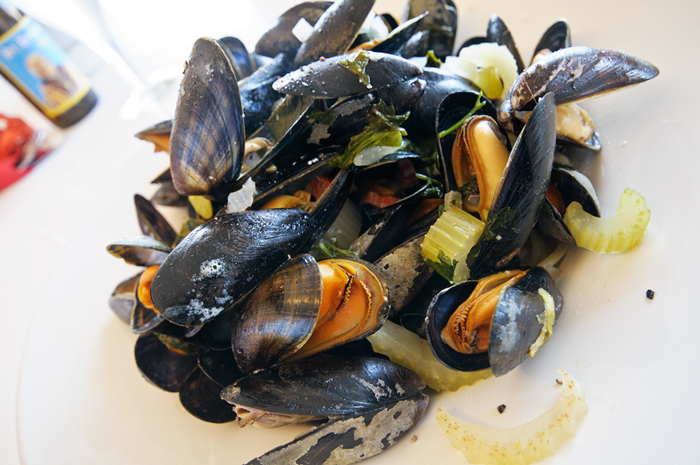
Classic moules marinières are a seafood favourite in Brussels.
2. Fries
Belgium’s national pride shines through in their fries, known as frites in French and frieten in Flemish, a culinary masterpiece in every bite. You’ll never hear a Belgian call them “french fries”, not even when speaking in English. There’s a lot of controversy around who invented fried potatoes, but I promise you – Belgians perfected them. Once you eat fries in Belgium, they’ll never taste as good anywhere else.
Belgian fries hide a delightful secret in their preparation, a two-fold process that ensures each fry’s unparalleled taste. First, the potato itself must be a soft variety, but, most importantly, the freshly cut potatoes must be fried twice: First at a lower temperature to cook the inside to a soft, fluffy consistency; and second, quickly at a higher temperature to cook the outside to crispy perfection.
While you can get Belgian fries at virtually any restaurant, they are invariably best from a genuine friterie (French) or frietkot/frituur (Flemish). These fry shops can be anything from a small building to a fry truck and the best ones are hotly contested and voted on annually. While most do serve other foods (all of them deep-fried), the emphasis is always on cooking fries to crispy, golden perfection.
Some friteries or fries shacks still serve their fries in traditional paper cones, while others have turned to the more convenient but less eco-friendly plastic containers. Either way, any good frituur will offer a mind-boggling array of sauces to choose from and, yes, most are mayonnaise based.
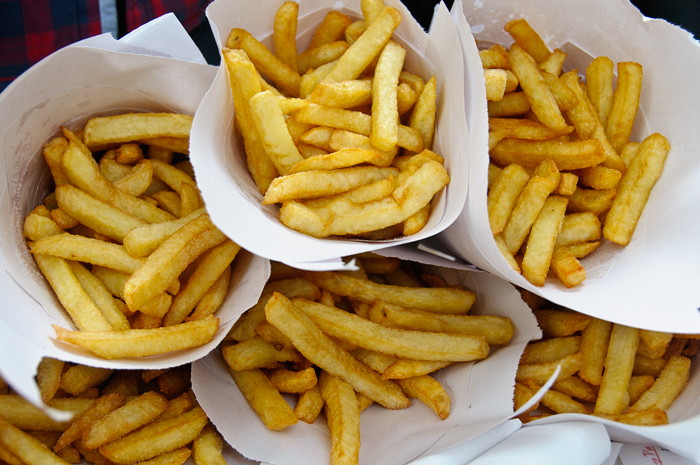
Belgian frites in traditional paper cones from Maison Antoine in Brussels.
But, trust me on this one, there really is a sauce for everyone – other than ketchup. A foray into Belgium’s sauce variety, like the garlicky aioli or the beloved andalouse, promises a flavorful journey with each dip. I’m a spicy kind of gal, so my go-to is samurai sauce, a kicked-up version of andalouse. If you’re brave, you can experiment with anything from peanut to curry sauces, so act Belgian and expand your sauce horizons.
There are 2 placed that you can try Fries in Brussels. The first one is Maison Antoine. There’s always a line at this outdoor Brussels food stand and that’s a great sign. You can also take your cone of fries to most of the local bars, as long as you order a drink. Maison Antoine is located in Place Jourdan, 1040 Etterbeek, Brussels. The second one is Fritkot, which is located at Place de la Chapelle, Brussels. This fry trailer is close to Grand Place but far enough that you won’t find many tourists. Grab a park bench and enjoy.
3. Meatballs
Belgian meatballs, a harmonious blend of beef and pork, reign as a cherished favorite across the nation, bringing warmth to every table. In Flanders, balletjes or “balls” are often served smothered in tomato sauce, or, sometimes, Frikadellen-style; fried in butter with Belgian cherry sauce.
South of Brussels, boulets Liégeois are the rage. These meatballs are served with a rich sauce of beef stock, spices, and sirop de Liege, a fruit syrup a bit like molasses, made from apples and pears.
Whichever style you prefer, you can guarantee they will come with crispy Belgian fries.
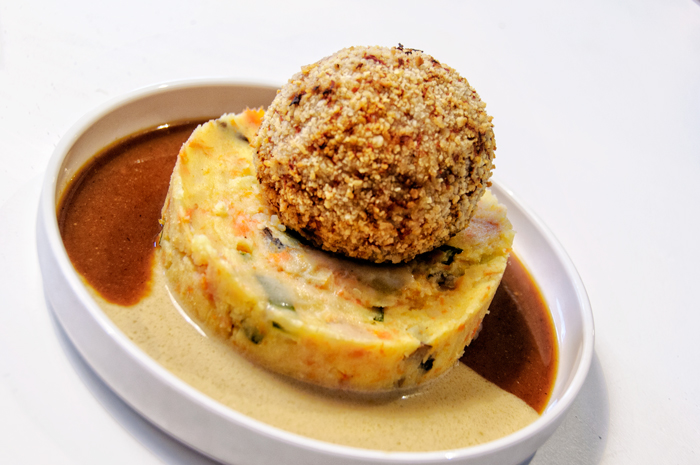
A giant meatball and stoemp from Balls & Glory.
You can try belgian meatballs in Brussels at Le Bistro. I guarantee these will be the best meatballs you’ve ever eaten. Using locally sourced, mostly organic ingredients. Le Bistro serves up giant meatballs filled with a variety of sauces. The balls are mainly pork, but there are beef, lamb, chicken, and even veggie versions available. Your ball comes served on stoemp (a potato and veggie mash) or with a salad. Try the blue cheese or truffle varieties, or stick to the ‘retro-balls’, the way grandma made ‘em.
4. Flemish Stew
If Alison Cornford-Matheson from Cheeseweb had to pick one favourite Belgian dish, it would be Carbonnade à la flamande (French) or Stoofvlees (Flemish). This Flemish stew literally translates to “stew meat” and that’s a pretty accurate description.
This typical Belgian food is made from beef slowly simmered in Belgian beer until it melts in your mouth. The sauce is thickened with a few slabs of bread slathered in mustard, a bit of onion, and some seasoning. Some chefs add other ingredients like mushrooms or garlic, but the traditional recipe focuses on Belgian beer and beef.
Flemish stew, transcending its humble ingredients, weaves a rich tapestry of flavors, deeply comforting to the soul. In the right hands, it can be both rich and slightly tart from the beer. It’s the perfect comfort food on a wet winter day, especially as it is invariably served with French fries or mashed potatoes. It warms you from the inside out.
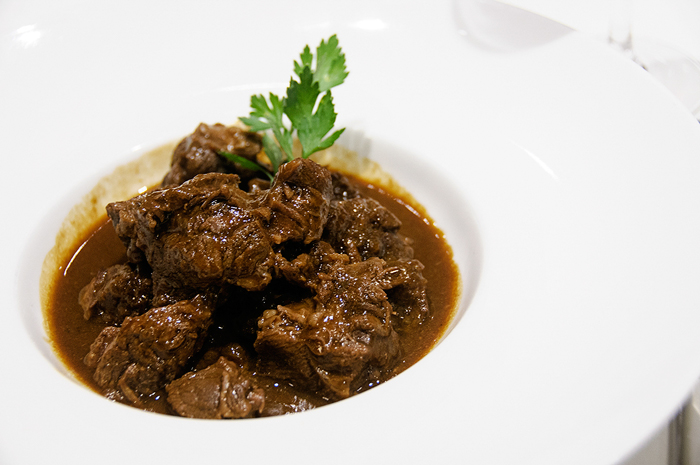
Hearty Flemish stew warms you from the inside.
You can eat the best Flemish Stew at Café Novo, just a short walk from Grand Place. This café does a great, traditional Flemish stew. The stew is always served with fries. Café Novo is located at Place de la Vieille Halle aux Blés 37, Brussels
5. Grey Shrimp Croquettes
North Sea grey shrimps, tiny yet flavorful, hold a special place in the heart of Belgium’s seafood tradition. If you dine at one of the many seafood restaurants in the Sainte-Catherine neighborhood in Brussels, chances are you’ll be presented with a small bowl of these crunchy crustaceans to snack on.
Not only are grey shrimps sweet and delicate, they are part of Belgium’s cultural heritage. Traditionally, these shrimps were harvested along the coast, from France to the Netherlands, by fishermen on horseback.
The only place this tradition is still practiced is the village of Oostduinkerke, on the Belgian coast, and it was recently inscribed on the UNESCO list of Intangible Cultural Heritage of Humanity. If you have the opportunity to see this spectacle you definitely should.
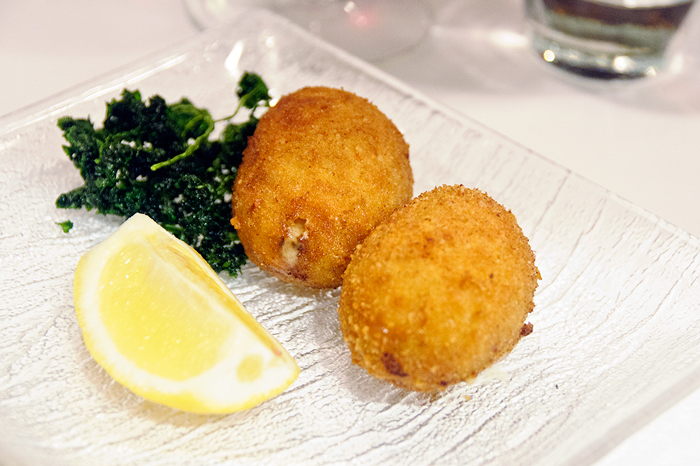
Hot and crispy shrimp croquettes from Les Petits Oignons, in Brussels.
Alison’s favorite way to eat grey shrimps is in a shrimp croquette, (garnaalkroket in Flemish). While there are plenty of bland, frozen, and refried versions served around Brussels, croquettes made from scratch are a revelation. The outside should be a thin, delicately crispy crust. When you break through, the creamy shrimp mixture should be molten and oozing. They make a perfect starter or snack.
There are two places in Brussels that serve the most tasty Grey Shrimp Croquettes. The first one is Noordzee / Mer du Nord, which is located at Rue Sainte Catherine 45, Brussels. For a truly local experience, order your croquettes (and a glass of white wine) from this fish counter on Place Sainte Catherine. It’s a local favourite, especially in the summer. These are my favourite croquettes in Brussels. The second one is Les Petits Oignons, which is located at Rue de la Régence 25, Brussels. If you prefer to try your croquette sitting down, this restaurant is a close runner-up for the best shrimp croquettes in Brussels.
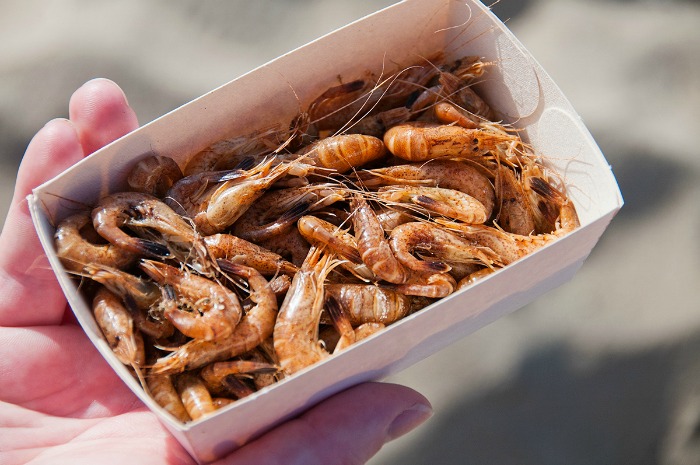
Grey shrimps are part of Belgium’s cultural heritage – They’re tasty too!
6. Waffles
Are you ready for something sweet? I thought so! When you think “Belgium” and “sweet”, Belgian waffles are one of two things (chocolate!) that immediately come to mind. As with “French fries”, there is some confusion about the term “Belgian waffles”. In fact, there is no one Belgian waffle, but rather two types of waffles, both originating in Belgium.
Brussels waffles, known locally as gaufre de Bruxelles, boast a rectangular and flaky texture, each bite a whisper of sweetness. It isn’t as sweet as its rival but is often topped with whipped cream, chocolate, ice-cream or various fruit toppings.
The denser Liège waffle has rounded edges and crystallized sugar baked into it, making it slightly sticky and sweeter than the Brussels waffle. This is the kind that’s sold from hole-in-the-wall places everywhere in the center of Brussels.
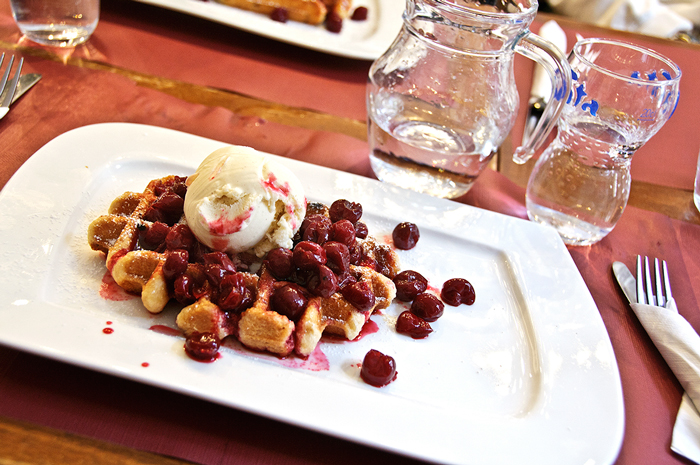
My favourite Liege waffle from the Dandoy Tearoom in Brussels.
Whatever you do, avoid buying the over-priced waffles at the shops around Grand Place that are covered in way too many toppings. (In fact, waffle purists say you shouldn’t top your waffles with anything). You can get both types of waffles from trucks (usually painted yellow) parked around most tourist hot-spots in the city.
There is also a surprisingly good chain, called Belgaufrecuy, found in most metro stations around the city center, adding a tasty smell to the many less pleasant smells of the Belgian underground.
If you want to fancy things up a bit, my favorite Belgian, or rather Liege, waffle comes from the Dandoy Tearoom, steps from the Grand Place. Dandoy is a traditional Belgian cookie maker, with shops around Brussels. From the street level, the Dandoy shop on Rue Charles Buls looks much like the others. But step inside and you will see a couple of differences.
Firstly, there is normally someone making fresh waffles behind the counter, to sell as takeaway treats. Secondly, you’ll notice a set of stairs, heading up to the Tearoom. There, you can sit and enjoy a waffle at your leisure, while admiring the collection of antique speculoos molds decorating the walls.
7. Eel in the green
Eel in the green is exactly what it sounds like: eel prepared in a highly green sauce which is colored that way because of the many green herbs that go into it, such as parsley, watercress, and basil. The herbs are added last minute to have them retain their color and the dish is commonly served with, of course, fries.
It’s more of a flemish dish than a Belgian food. Fishermen used to catch the eel in the river Schelde, close to Antwerp, and then prepare them with whatever herbs they found along the shore. Now often served in the more classy bistro, it has a very humble origin.
You can eat Eel in the green in Brussel at Bij den Boer, which is located at Quai aux Briques 60, Brussels. Also, the restaurant Victoria – Chez Victorine in Hoeilaart (Marcel Félicéstraat 17) is known for this dish.
8. Rabbit with prunes
Rabbit with prunes used to be a “humble people dish” but in recent years it’s been picked up by chefs around the country and presented in more refined ways. The classic version of this Belgian dish combines rabbit with prunes to add sweetness and some croquettes on the side.
Try it at La Roue d’Or, which is situated at Rue des Chapeliers 26, Brussels. It is a local brasserie close to Grand Place.
9. Sausage and mash
Granted, it’s nothing special, but sausage and mashed potatoes is a classic Belgian combination that’s now mainly served by grandparents or restaurants known for serving Belgian cuisine. It’s a hearty farmer’s dish and the kind of sausage used ranges from black to white and blood sausage. Often, the mashed potatoes will be mixed with a vegetable, like carrots, to create stoemp, the typical Belgian kind of filling mashed potatoes.
Try sausage and mash at Fin de Siècle, at Rue des Chartreux 9, Brussels. Fin de Siècle serves its sausage and mash the traditional way.
10. Steak tartare and martino sandwich
Not everyone’s a fan of steak tartare. This typical Belgian food consists of raw beef mixed with onions, mayonnaise, Tabasco, egg yolk, capers, salt and a bunch of other things. Restaurants that take pride in their steak tartare will prepare it right at your table, showing you all the ingredients that go into it. As often in Belgium, this dish is mostly served with fries.
Not quite the same, but it needs to be mentioned, is the Martino sandwich. You could say it’s the less pricey and on-the-go version of the steak tartare and beloved by many Belgians. I know several women who craved a Martino while they were pregnant as they couldn’t have it then, and several people who place it almost as highly as fries as the dish to have after a trip abroad.
So what is it? It’s a baguette with a spread of “Américain”, a form of steak tartare but as a sandwich spread, with spices, pickles, onions, and ketchup. Every itself-respecting sandwich bar will have it on its menu.
Eat the best steak tartare at Bistro Mathilda in the Belgian coastal city of Oosten. Bistro Mathilda is known for its steak tartare, prepared at your table. This place is always packed and when you sample its refined cuisine, you’ll know why.
11. Ham and Belgian endive in the oven
Belgian endive is a typical Flemish vegetable and I remember my grandmother making ham and Belgian endive in the oven quite regularly when I was small. She would take slices of beautiful ham and wrap them around a whole knob of Belgian endive. The wraps would go into an oven dish, covered with a béchamel-and-cheese sauce. With mashed potatoes on the side, this dish is a classic of Belgian cuisine.
Belgian endive is one vegetable I’ve never been a fan of, so my grandmother would always leave a couple of rolls fo ham empty for me :-)
12. Vol-au-vent
Vol-au-vent consists of a round puff pastry of which the “lid” is cut off so that the pastry can be filled with a mixture of chicken and mushrooms in a creamy sauce. It’s usually served with fries, croquettes or mashed potatoes. Originally, the name “vol-au-vent” refers to the pastry and you can also find it in France as a snack or appetizer. Vol-au-vent as a massive main dish, though, is a typical Belgian food.
There are two amazing places to eat Vol-au-vent. The first one is ‘t Cuyperke. It is located in Zaventem (Stationsstraat 19), just outside of Brussels, and serves a mean vol-au-vent. The second one is Les Petits Oignons, at Rue de la Régence 25 in Brussels.
13. Speculaas
While sometimes translated as “Gingerbread”, speculoos is a unique kind of biscuit. It goes back to the Belgian and Dutch tradition of celebrating Sinterklaas (Saint Nicholas) on December 5/6 (Netherlands/Belgium) but has become commercialized and can now be found in stores throughout the year.
Often, when you order a coffee in a Belgian cafe, it’ll come with a little speculoos on the side. Try dipping it in and see how it tastes. It’s not bad!
14. Jenever
Jenever or “Dutch gin” comes in all kinds of flavors and is served in a small shot-like glass. It’s origins date back to the 14th century when the Arabs invented distillation and brought it to Europe and Belgium wouldn’t be founded for still a few centuries.
Now, the drink is typical both for Belgium and the Netherlands and especially in Belgium it’s mostly a Christmas drink. At Belgian Christmas markets, you’ll see stands only selling jenever and like some people visit Christmas markets for the Glühwein, Belgians will go to have jenever.
We even have a National Jenever Museum!
15. Asparagus Flemish-style
When it’s asparagus season, from April to June, the country goes asparagus crazy. You’ll find them in appetizers, main courses and even as ice cream for dessert. While there are many ways to prepare asparagus, Flemish-style is the classic way to have them. Boiled, then baked in a butter sauce and covered with hard-boiled pieces of egg, they make for a rich vegetable dish to combine with meat and croquettes. Or, why not, fries.
Travelers can enjoy Asparagus Flemish-style at Le Zinneke. It is a good place to go if you want to sample typical Belgian cuisine. They’re known for their white asparagus Flemish-style, but make sure to go when it’s the season. Le Zinneke is located in Vaderlandsplein 26, Schaerbeek.
What are the regional specialties in Belgium?
Aside from the Belgian dishes listed, there are also a ton of regional specialties. Some you’ll also find outside their region of origin, others hardly. It would be a bit crazy to list all regional foods in Belgium, so I just want to name a few.
Gentse Waterzooi originated in – indeed – the city of Ghent and consists of a stew with carrots, onions, celeriac, leeks, potatoes and a bunch of herbs in a watery soup based on egg yolk, cream and vegetable broth. Originally, the stew was made with fish but nowadays the use of chicken is more common.
I already mentioned syrup from Liège when talking about the meatballs, but this regional specialty also goes really well on a sandwich combined with bacon or cheese. Honestly, try it!
A final regional specialty I want to mention, are the mattentaarten, a round kind of cake made with different kinds of milk, almonds and puff dough.
What is the most famous Belgian food?
Aside from waffles, the most famous Belgian food are beer and chocolate. I haven’t listed them separately in this post because they both form a more general category of Belgian foods, rather than one thing. If you’d like to have some proper Belgian chocolate, head toward the Sablon area in Brussels. There you’ll find famous names like Pierre Marcolini. A lesser-known favorite of mine is Frederic Blondeel.
While lots of the bigger beers can be had all over Belgium, in origin, Belgian beers are still very much connected to their region of origin.
What are the best Belgian dish recipes to cook yourself?
Belgium has a strong culinary identity, influenced by its connections to various European countries and rooted in historic recipes that have persisted for centuries. The best Belgian recipes to explore include “Steak tartare”, a delectable mix of finely chopped raw beef combined with shallots, pickles, and capers; “Waterzooi”, a comforting stew originating from medieval Ghent, often made with chicken; “Dame Blanche”, a vanilla ice cream dessert topped with a rich chocolate sauce; “Chicken vol au vent”, a puff pastry shell filled with chicken and other ingredients; the famed “Flemish stew” made with Belgian beer; “Salade liegeoise”, a potato salad with bacon and egg; a seasonal treat of boiled “Asparagus” topped with egg salad; and “Belgian endive in the oven”, a homey dish combining roasted endive with cheese and ham. For those eager to delve into Belgian cuisine, these dishes are both delightful and accessible, showcasing the nation’s rich gastronomic heritage.
What are the best restaurants to eat in Brussels as a visitor?
Listed below are the best restaurants in Brussels:
- Restaurant Le Rabassier: Restaurant Le Rabassier in Brussels is a famous dining establishment specializing in exquisite French cuisine. It is ideal for special occasions, with a menu featuring classic French dishes like foie gras and escargots. It is known for truffle-based delicacies, where guests can savor truffle risotto and truffle-topped steaks.
- Comme Chez Soi: Comme Chez Soi is an acclaimed restaurant with a rich history dating back to 1926. It offers a blend of traditional and innovative dishes using high-quality ingredients. It has a changing menu that incorporates seasonal products, guests can expect a memorable dining experience. The restaurant is closed on Sundays, Mondays, Tuesdays and from December 24 to January 09.
- Fin de Siecle: Fin de Siècle Restaurant in Brussels is a popular dining spot known for its authentic Belgian cuisine, just 1 kilometer from the Grand Place. The menu showcases classic dishes like moules frites, carbonnade flamande and waterzooi. Guests can also enjoy a variety of Belgian beers.
- Fanny Thai: Restaurant Fanny Thai in Brussels specializes in authentic Thai cuisine. The menu offers a variety of flavorful dishes prepared with fresh ingredients and aromatic spices. Guests can enjoy classic favorites like Pad Thai, Green Curry and Tom Yum Soup and vegetarian and vegan options.
- Le Plattesteen: Le Plattesteen in Brussels specializes in Belgian cuisine, offering a menu filled with traditional and flavorful dishes. Guests can enjoy Belgian classics like Moules Frites, Carbonade Flamande and Waterzooi. The restaurant caters to different dietary preferences with vegetarian and seafood options.
Visitors should definitely read our guide of 15 Best restaurants in Brussels: Where to eat in Brussels before visiting Belgium’s capital
What are the best food tours in Brussels?
If you want to get some more background information while you enjoy Belgian food around Brussels, consider going on one of the following food tours. All of these get great reviews.
Listed below are the best food tours in Brussels.
- Brussels Chocolate Walking Tour and Workshop. During this 4-hour tour, you’ll stop at the best chocolate boutiques in Brussels to sample pralines, truffles and more while learning about the history of Belgian chocolate. Afterward, you’ll get to make your own chocolates during a workshop with a chocolatier. The choice to take your creation home or eat it the same day is all yours. The tour costs €69 per person and you can book it here.
- Express Tour with Belgian Lunch, Chocolate, & Beer. On this 3.5-hour walking tour, you get to try typical Belgian dishes such as “waterzooi” and stew but also typical treats such as waffles. The tour also includes a chocolate and beer tasting. The tour costs €89 per person and you can book it here.
- Brussels Chocolate Tasting Tour. This 2-hour tour takes you to some of the best chocolate shops in Brussels while your guide tells you all about the history of this brown gold in Belgium. As an extra, the tour takes place around the beautiful Grand Place and Saint Catherine areas. The tour cost only €65 per person and you can book it here.
- Brussels Private Food Tour with 10 tastings. During this 3-hour private tour, a local guide will tell you all about the culinary scene in Brussels while you try some street food, hop into deliciously smelling shops, wander through the market and have a break at an old-fashioned cafe – plus so much more. The tour costs €152 per person and you can book it here.
What are the most unique facts about Brussels?
Listed below are the most interesting facts about Brussels.
- Yellow Iris Symbol: Brussels’ emblem is the yellow iris, seen on the Brussels-Capital Region’s blue flag.
- Diverse Museums: Brussels boasts over 80 unique museums, from sewage to underwear history.
- Chocolate Hub: Its airport leads globally in chocolate sales, dispatching 800 tonnes annually.
- Food Haven: The city contains 138 restaurants per square mile, with one even being a tram-restaurant.
- Rainy Climate: With 132 rainy days a year, it has an average temperature of 10.3°C.
- Manneken Pis: A beloved urinating boy statue captures Brussels’ humor, now safeguarded in a city museum.
- Grand Palaces: The Royal Palace of Brussels rivals Buckingham Palace in size.
- Cosmopolitan City: 27% of Brussels’ residents are foreign, and three languages are officially spoken.
- Fries Origin: The globally known french fries have their roots in Belgium’s late 1600s.
- UNESCO Grand Place: The Grote Markt stands as a UNESCO World Heritage Site and cultural hotspot.
- High Population Density: The City of Brussels packs 14,200 residents per square mile.
- Grand Justice Palace: Once the world’s largest structure, it remains a European marvel.
- Brussels Sprouts: These green veggies trace their lineage back to 16th-century Brussels.
- Beer Galore: Brussels is home to over 800 beer varieties.
- Historic Shopping Arcades: The Galeries Royales Saint-Hubert, Europe’s oldest shopping arcades, debuted in 1847.
- The Atomium: This iconic structure mimics an immensely magnified iron crystal cell.
- Ancient Settlement: Established in 979 AD, the region saw settlements as early as 580 AD.
- Global Diplomatic Hub: Housing entities like the EU and NATO, Brussels teems with journalists and diplomats.
- Dinosaur Museum: Europe’s largest dinosaur display resides in the Brussels Museum of Natural Sciences.
What are the most fun things to do in Belgium?
Listed below are the best things to do in Brussels.
- Taste a Waffle: Belgium is renowned for its waffles. Notably, there’s no single “Belgian waffle”. Instead, there are regional varieties like Liège and Brussels waffles.
- Explore a Castle: Belgium has the highest density of castles per square kilometer. A prominent one is the Gravensteen in Ghent.
- Experience the Beer Culture: Belgium boasts between 800 to 1,000 different beers. The nation’s beer scene is so esteemed it’s a UNESCO World Heritage site. The Halve Maan in Bruges is a notable brewery.
- Visit a Beguinage: Unique to Belgium and the Netherlands, Belgium’s beguinages are UNESCO World Heritage sites. The Grand Beguinage in Leuven stands out for its serenity.
- Commemorate the World Wars: Belgium’s history is marked by both World Wars. Tourists often visit sites like Flanders Fields and Breendonk Fortress to remember these events.
- Visit a Christmas market.
Additionally, history enthusiasts can climb the Lion’s Mound in Waterloo, marking Napoleon’s defeat. Comic book fans will appreciate characters like Tintin and the Smurfs, with dedicated museums like the Comics Art Museum in Brussels. And while in Brussels, a stroll over the Grand Place, which is one of the best things to do in Brussels due to it’s historic significance.
What is the best time to visit Brussels and Belgium?
As with all destinations, the best time to travel to Belgium depends a bit on what you’re looking for. Belgian weather can never be trusted, but the nicest time of the year is usually from June until September. I’d recommend to visit anywhere between the second half of May and the end of September if you’re looking for nice weather. Any other time is good, if you want to visit the cities in Belgium and don’t mind a bit of cold or rain. Visiting Belgium in July can be quite wonderful. It’s the time for outdoor dining, sunny cycle rides, picnics in parks, and more.
This post came about as a collaboration with Alison Cornford-Matheson, a Canadian travel writer and photographer and the founder of Cheeseweb.eu. She’s also a fun person to have food with and the author of The Foodie Guide to Brussels: Local Tips for Restaurants, Shops, Hotels, and Activities, available in digital and paperback formats.
PIN FOR LATER

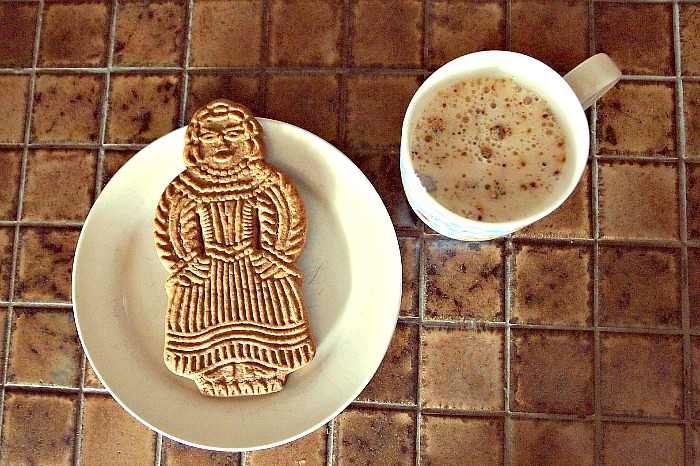
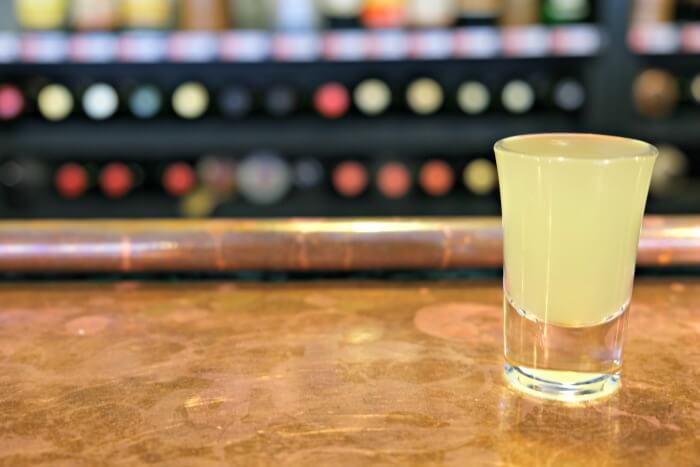
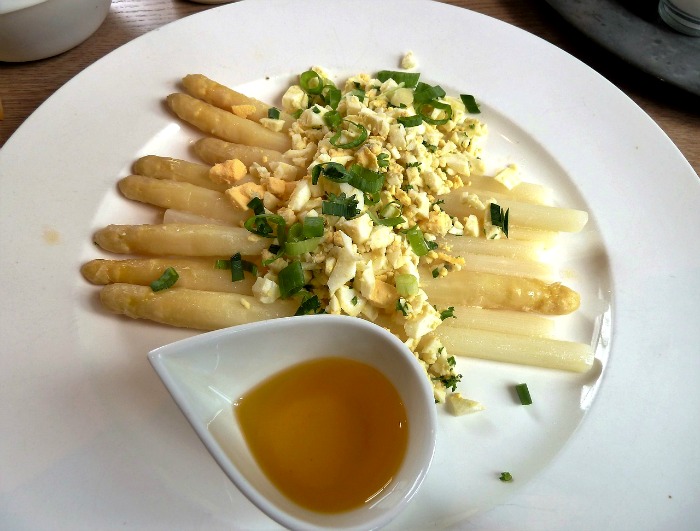
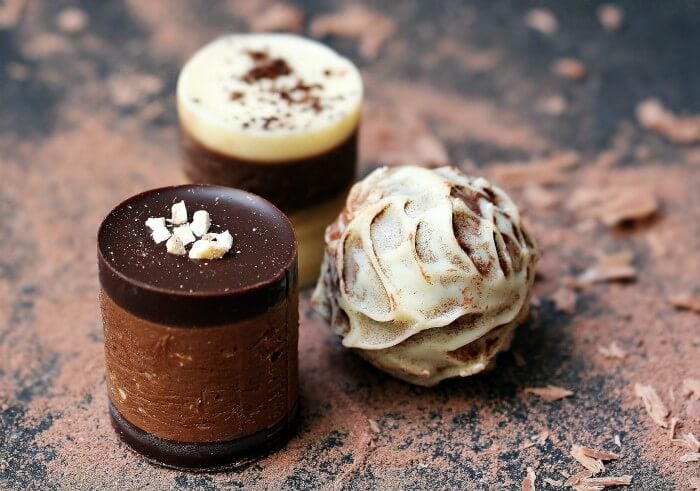
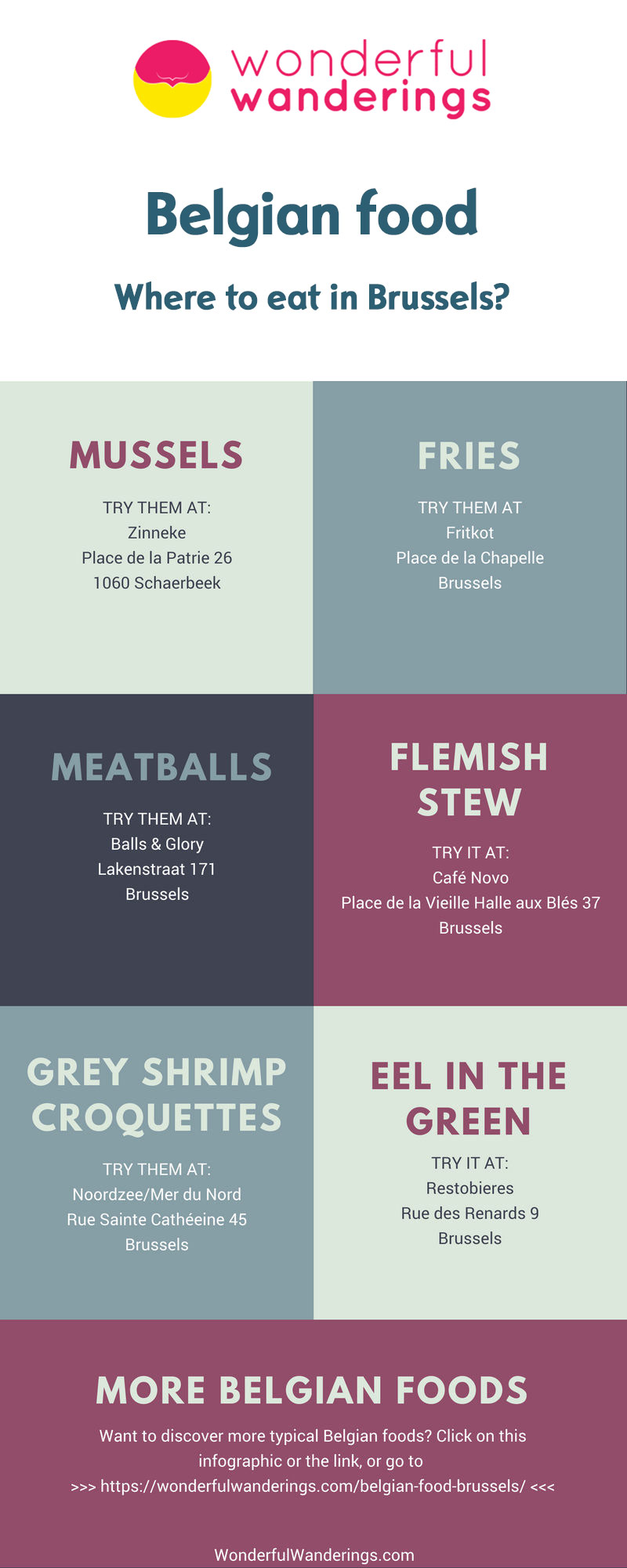
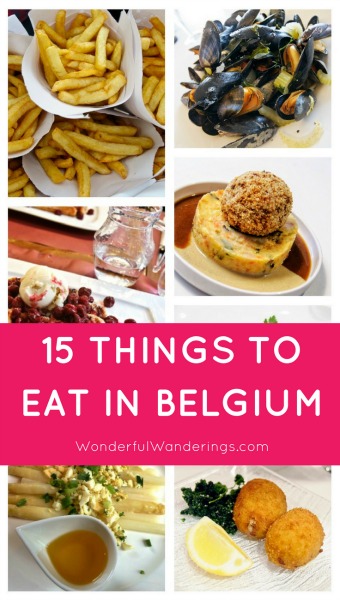
Travelsito says
Looks delicious!
Sofie says
I agree:D
Alison says
Thanks for giving me the chance to share a small taste of my passion for Belgian cuisine Sofie!
Sofie says
Thanks so much for sharing it with us!
Kate and Mike says
Nice list! Love the frites at Antoines. We have always loved the Belgian stew and the moules at L’Entree des Artistes in the Sablon. Cafe Dandoy for gaufres is an excellent recommendation.
There is one more dish, however, that merits mention: Waterzooie (a chicken and vegetable stew in a thin béchamel sauce). The definitive version is at Aux Armes de Bruxelles in the Grand Place. Pairs best with a lovely glass of white wine.
Sofie says
That’s a good addition! But I’m sure I’m gonna do a follow-up post of this. There is so much more goodness to share:)
Alison says
Definitely, Waterzooi is a great one and It was hard for me to narrow down the list. (I have a lot more classic dishes in the book.) I had an excellent Waterzooi at Les Filles, but as it is table d’hote-style, with no set menu, they don’t always have it.
lema says
LES PETITS OIGNONS Definitely the best SHRIMP CROQUETTES that I have ever eaten.
Sofie says
Hahahaha :D Wonderful!
Francoise says
The “friterie de la barrière” is even qualitative than “friterie Antoine” and even more because it is not a product chain for tourist and with a waiting queue really shorter.
Tay says
I loved everything about this post! I went to Belgium last year and absolutely fell in love! I remember every time we would eat out, they would bring a huge bowl of fries to the table. I never knew it was such a huge thing there! They were sooo good!
Sofie says
Hahaha I’m soooo happy you loved the food over here! Eating is a big deal for us and so are our fries :D
Kicko says
A sister of my friend ex husbands invite us for Brussels. I love it mussels and sure I like culinary. Your picture make me want to try all…
Sofie says
I’m happy to read that Kicko! Mussels are so goooood, especially with fries :D
KOEN says
As a Belgian myself this was a challenging title, yet after long and carefull consideration I concur that these are indeed 6 dishes that form an excellent starting point to discover the 6000 other excellent Belgian dishes.
Sofie says
I’m glad you agree, Koen :) And I think Alison specifically didn’t call it “The 6 MOST popular…” :D
Maribeth Alexander says
The foods look wonderful! I saw several I would love to try! Thanks for sharing.
Sofie says
Hey Maribeth, thanks for commenting!
I’m happy that you think so :-)
Mike Hinshaw says
Found this just in time. We fly in early Sunday morning. Not sure how many we can try. Only staying one week darn it. All my wife could get off. Time to retire I told her! Thanks for the suggestions young lady.Tell your Dad hello!
Mike
Sofie says
Hahaha that’s good advice :) I will. Have a good time!
Mike Hinshaw says
Sofie,
We had frites at Maison Antoine and we couldn’tfinish the large order. I got the “curry” sauce and will get that every time. I lovedit.
You need to try the Mussels at “Au Veaux Bruxelles”. They were fantastic, if you haven’t been. Sorry we didn’t get a chance to get together. Maybe in December.
Mike Hinshaw
Sofie says
So funny you got the curry and loved it so much :-) I do think you should get mayonnaise or sauce Andalouse the next time, though :
Recommendation noted!
Gunther says
Classic list!
One small thing: “bladder dough” doesn’t exist in the English language, it’s “puff pastry”.
A bladder is the organ which (in humans) holds your urine.
Sofie says
Hah, thanks! I know what a bladder is but it still sounded good :D Correcting that now :)
Wim says
From BE, this one made me LOL. It’s like a funny literal translation of something :-) In Dutch/Flemish it’s called ‘Bladerdeeg’ -> ‘Bladder dough’. Love the article by the way, got me hungry ;-)
Sofie says
Haha thanks :) I clearly shouldn’t edit my own translations :)